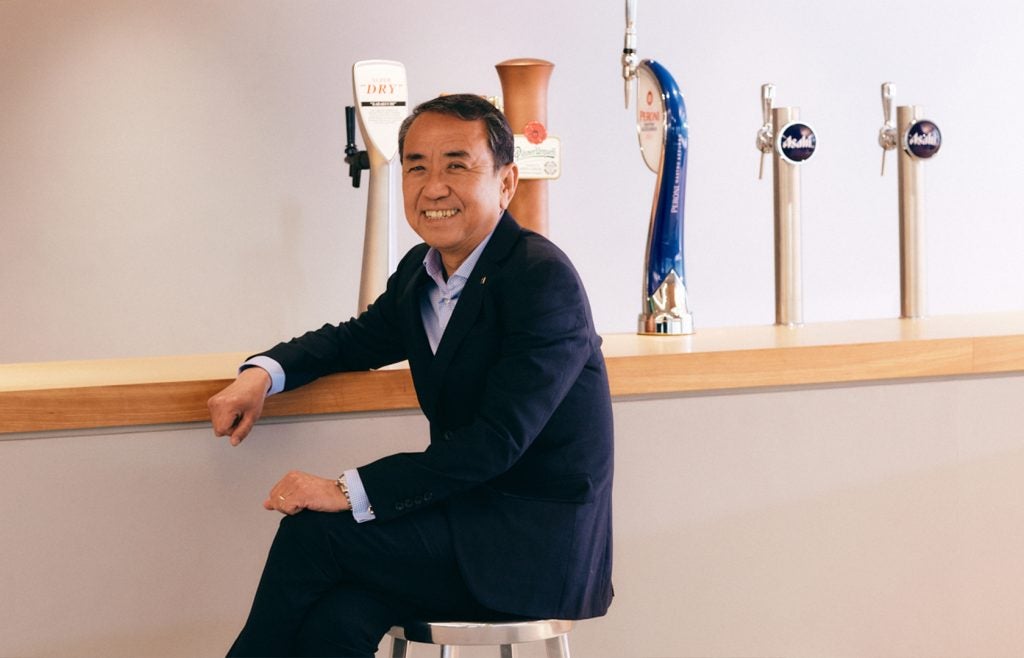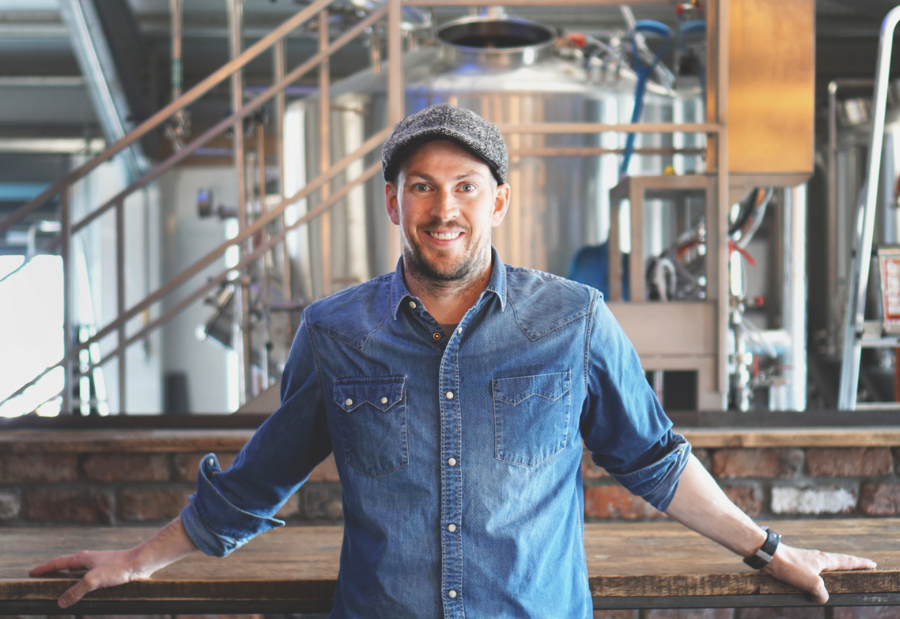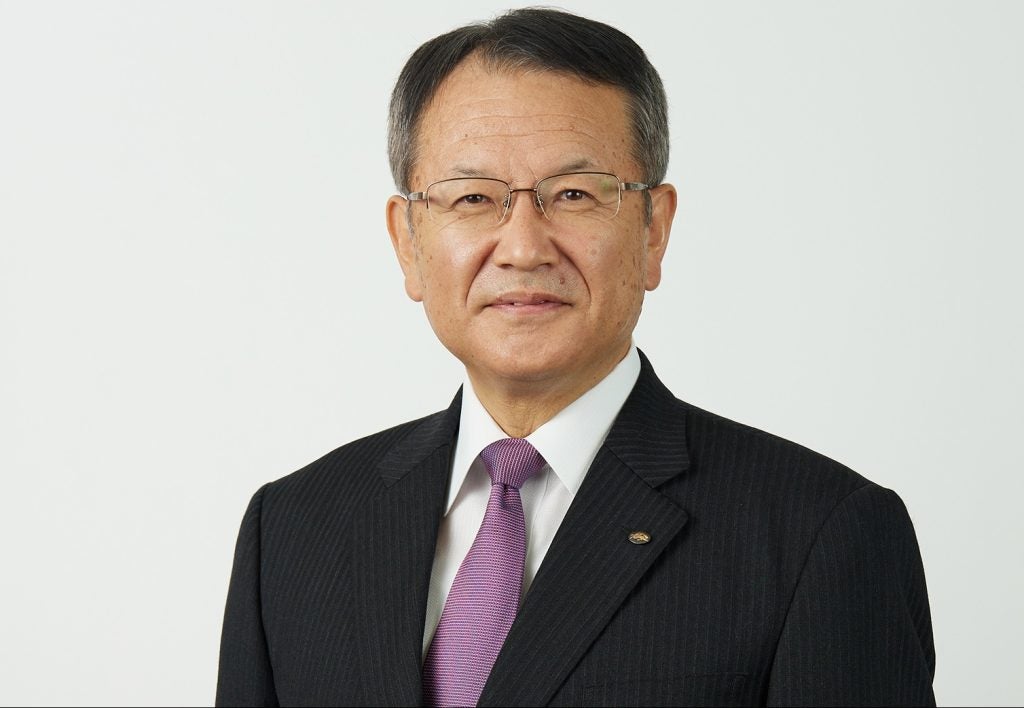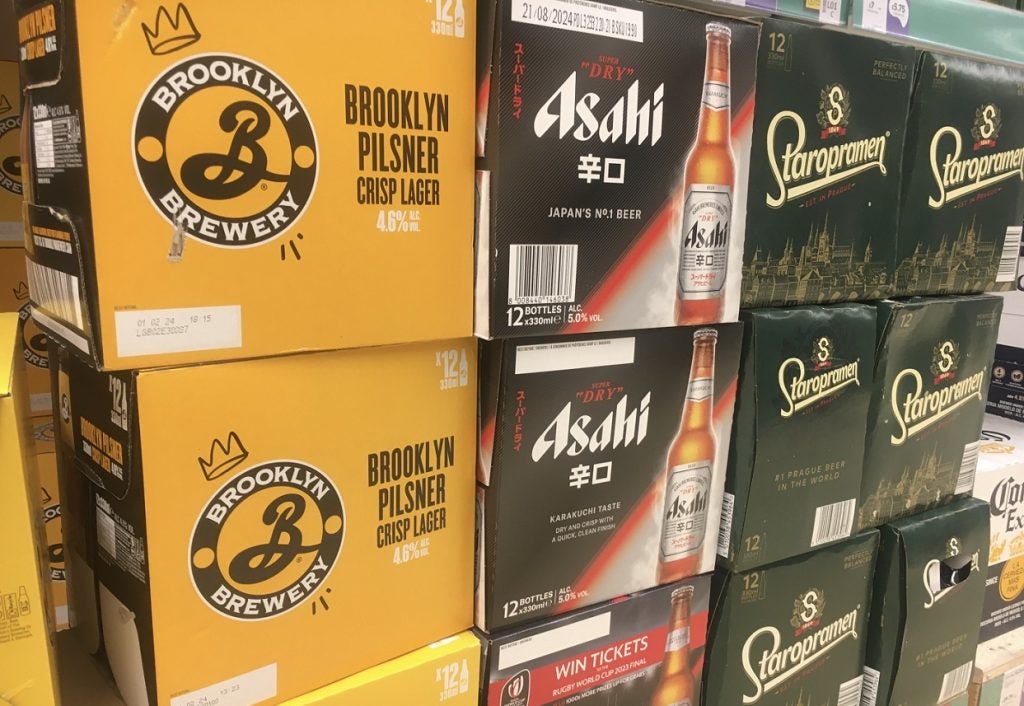As we enter another new year, Just Drinks has spoken to senior figures at four of the beer industry’s biggest names to get the inside track on how they see 2024 taking shape.
Jacob Aarup-Andersen, Carlsberg’s CEO

Do you expect to see volume growth this year? Do you remain cautious about demand in parts of Europe and south-east Asia?
Between Covid, the terrible war in Ukraine and inflation, it’s fair to say the past few years have been extraordinary and challenging. But knowing that Carlsberg has a strong foundation and a healthy financial position, we’re well-positioned to invest in our brands and markets to capture attractive long-term growth opportunities. We are currently carrying out a review of our strategic priorities to ensure that we prioritise the right growth levers. We will shed more light on the conclusions from the review when we publish our full-year results on 7 February. I am a firm believer in compounding earnings growth – and that can only be achieved if we succeed in growing our volumes and revenue/hl.
How do you think cost inflation will impact Carlsberg's beer business in the coming year? What steps are you taking to mitigate the impact of that cost pressure? Will you look to increase prices again?
Our best estimate at this time is that we will see flattish COGS/hl in 2024. However, while COGS/hl may be flattish, we see continued inflation in other cost groups, such as salaries, sales and marketing and logistics. We intend to offset the higher cost/hl through value management initiatives, which will vary by market, but we cannot rule out price increases.
How do you see consumer demand for beer across your markets this year?
We are always careful about forward-looking statements about consumer demands and pricing. We are still facing challenges and uncertainties around Europe and also in Asia, where the challenging macro situation in China is impacting other markets in south-east Asia. This may affect the consumer demand for beer.
What consumer trends do you expect to drive your innovation and NPD pipeline in the next twelve months?
We see great potential in our product range within alcohol-free beer. This aligns with our strategy that 35% of our brews globally will be low-alcohol or alcohol-free within 2030. The alcohol-free beers have grown fast and we are proud of our leading position in several markets. We have also seen increased demand premium products, such as 1664 Blanc.
On which key ESG issues do you expect to increase investment in 2024 and why?
We will be making new investments towards the ambitious targets and commitments that we have set out in our ESG programme. Our 2024 investments will include those focused on further decarbonising our value chain and transitioning towards regeneratively grown barley, as well as replenishing all water consumed by breweries in water scarce areas, reinforcing diversity, equity and inclusion amongst our people and maintaining high health and safety standards across the board.
Overall, what are the biggest challenges you think Carlsberg will face this year?
It will be an interesting year to come and we do see a great potential in our portfolio of premium brands, alcohol-free beer and accelerate core markets in Asia including China, Vietnam and India.
Over the last three years, we have faced a lot of challenges and uncertain circumstances with Covid, war, and inflation. We are still facing uncertainties worldwide but we as a company have strong market positions, very attractive brand portfolios and a very healthy financial position.
Asahi Group Holdings CEO Atsushi Katsuki

What are Asahi’s best opportunities for sales growth in 2024?
We see a significant opportunity for sustainable growth in our beer-focused businesses, particularly through the strategy of premiumisation. In light of the current economic climate and inflation trends, we are maintaining realistic expectations and do not foresee a substantial surge in sales volume across all regions.
Despite enduring substantial cost increases over the past year, we have successfully managed to raise our unit sales price in all regions. This can be attributed to our prudent pricing strategies, our focus on premiumisation, and our efforts to enhance our competitive advantages, such as improving our market position and brand metrics in each region.
It’s important to note that although there’s been a temporary decrease in demand for premium products in some markets due to inflation and price hikes, overall consumer interest in superior quality products and services remains high.
How do you think cost inflation will impact Asahi in the coming 12 months? How does that compare to 2023?
In 2023, we expect to have seen an increase in variable costs across our group of approximately Y100bn ($691.7m), primarily driven by the rising costs of raw materials and energy. We are currently conducting a thorough review of conditions to determine our outlook for the next fiscal year.
Our expectation is that total costs will slightly increase in 2024. While we anticipate some benefits from softening market conditions for certain raw materials and energy, we also foresee a wave of continued requests from suppliers for price increases, along with further rises in labour, conversion and other costs.
In response to this, we remain committed to ensuring profitability by continuously investing in our premium category and main brands. Furthermore, moving forward, the consolidation of global procurement functions, led by Asahi Global Procurement Pte. Ltd., and the resulting improvement in efficiency will strengthen cost management over the medium- to long-term.
In terms of pricing strategies, multiple facets need to be considered. We will delve into this as necessary, guided by ongoing cost increases, inflation trends, demand trends, and other factors.
What are the biggest ongoing supply chain issues Asahi is facing and how will you seek to combat them?
As our business continues to expand, we are increasingly coming across a number of supply chain challenges that require effective management. We are seeing risks related to procurement, including soaring prices due to changes in market conditions, natural disasters and various issues arising from pandemics and geopolitical problems.
Addressing these challenges necessitates forming strategic partnerships with key suppliers to reduce risks and facilitate stable procurement activities. We must expedite our collaborative efforts with suppliers on a range of issues. These include tackling climate change – particularly by reducing CO2 emissions – and ensuring the sustainable procurement of agricultural raw materials like malt and hops, as well as materials needed for packaging.
Asahi Global Procurement will begin operations in 2024, integrating the procurement functions of the Asahi Group. By strengthening strategic collaboration with suppliers, we expect to not only further generate group synergies but also contribute to solving various issues in the global environment and society, leading to the promotion of sustainable procurement.
How will Asahi use AI in 2024? Will you increase investment in AI? Longer term, how might AI benefit the business? What challenges do you see with the implementation of the tech?
We believe that AI technology is poised to be integrated into all facets of business and a company’s ability to leverage this technology will be directly linked to their competitiveness. It has already led to significant results in areas such as production sites and quality assurance.
Also, Asahi Group launched a trial implementation of generative AI in Japan in 2023 to improve operational efficiency, enhance capabilities, and gain consumer insights. We are in the process of gathering and analysing knowledge from this trial. We are considering the adoption of AI in various aspects of our business. This includes the development of products and services that tap into personalisation trends and the realisation of more efficient work styles.
While we address various challenges such as reducing risks associated with information handling and implementing training to improve employee literacy in this area, we believe that AI will play a key role in driving business innovation.
How do you see consumer demand across your geographic markets in 2024?
Recently, we have observed a temporary downtrading in some markets. However, as inflation begins to stabilise, we expect to see a resurgence in the growth trend within the premium category. We have not observed a significant shift away from consumer trends favouring high-quality and premium products and services.
Despite the challenging business climate brought on by significant cost increases, inflation and changes in consumer trends, we remain cautiously optimistic. Asahi Group plans to continue investing in its brands in 2024 and beyond to maintain and grow our competitive advantages in each region.
In the Alcohol Beverages Business in Japan, we will continue to invest in strengthening the beer category. The ongoing liquor tax reforms in Japan, set to continue until 2026, include a phased reduction of beer taxes. We are confident that this will provide a boost to our business operations within the country. Additionally, we aim to expand the premium category, including non-alcohol beer and global brands, in Europe, and enhance our value propositions in Oceania by leveraging our multi-beverage portfolio and implementing premiumisation strategies.
James Watt, CEO and co-founder of BrewDog

How do you see consumer demand for beer across your markets this year? To what extent do you anticipate drinkers to trade down and how will you react to that?
Inflation is coming down but, obviously, it still continues to put a squeeze on wallets. The start of the year is always tough for any consumer-facing business but we don’t expect to see our customers trade down because there remains a demand for fantastic, quality craft beer. Where we have seen some change, is some consumers buying less frequently but opting for higher quality.
How will your cost inflation compare to 2023? What steps are you taking to mitigate the impact of that cost pressure? Will you look to increase prices again?
Like all businesses in the sector, cost inflation remains a major concern but we’re confident the strength of our brand and the support from our loyal customers will stand us in good stead for the coming year. We haven’t got any plans to adapt our pricing but we are monitoring it closely. Where we are focusing intensely is production efficiency, having really honed in on a strong beer range that meets all our community’s demands.
What are the principal challenges in BrewDog’s supply chain? Overall, how would you describe the supply-chain picture at the moment?
Supply-chain issues are naturally a continuing pressure on the business affecting our input costs, which we are managing very closely. But beyond this, the supply chain has a huge impact on Scope 3 emissions – as these are essentially all the emissions that aren’t produced directly by us, but including aspects like ingredients, transport, distribution, packaging and purchases from other suppliers. We’re very focused on driving efficiencies where we can and working closely with them to help reduce emissions where possible. For example, we worked closely with our e-commerce 3PL company to reduce packaging inserts to significantly reduce cardboard use for online purchases.
What are BrewDog’s best opportunities for sales growth in 2024, both in terms of its packaged business through retail and also its on-trade operations? Do you expect to see volume growth from packaged beer through retail?
Despite all the macroeconomic headwinds, 2023 was a strong year for us. We are still growing and expanding – having launched some great new beers, including Black Heart which has exceeded all expectations, as well as Wingman and Shore Leave which are both already proving popular. All three have huge potential to grow and be big for us this year.
We also announced our bold expansion plans to treble our bar footprint over the next seven years and opened bars in new locations such as Hong Kong and global travel hubs like London Gatwick.
In terms of off-trade, we already massively outperform our sector and will continue to strive to grow this part of the business. The on-trade remains very tough and hyper competitive but we’re confident we can build on our recent successes.
From a geography perspective, we’ve got big plans to grow our presence in China – the world’s biggest beer market – and capitalise on demand in countries such as India, where we expect to open a host of new bars in the next few years. We’re also seeing strong growth for us in mainland Europe where we’re working closely with distributors to launch brand campaigns in key territories.
Overall, what are the biggest challenges you think BrewDog will face in 2024? Conversely, do you have reasons for optimism for your business?
The three biggest challenges will continue to be the perfect storm of cost of living and inflationary pressures squeezing our supply chain and input costs. But we’re confident of weathering these and emerging stronger than ever.
For us, it’s always been about making fantastic, quality beer. And 2024 will be no exception. We have great strength and depth in our range which positions us strongly within the category and have exciting plans brewing – both in terms of new beers and bold, exciting campaigns which we’ve always been known for. Seeing the Lost Forest continue to become a reality is personally hugely important and exciting and fills me with great optimism and pride.
Hideki Horiguchi, president and CEO of Kirin Brewery Co.

In which geographic markets do you see the best growth prospects in 2024?
In 2024, we believe that opportunities are abundant due to the gradual recovery from COVID-19, changes in consumer mindset, and the transition between the beer categories following Japan’s liquor tax revision. In particular, the beer category (not including happo-shu or new genre beers) has been performing very well since the end of last year, partly due to the revision of the liquor tax. We will continue to meet the growing demand for beer with our Kirin Ichiban brand, which offers a rich lineup with different tastes, and the Spring Valley line-up of craft beer, which we are working on as a new growth driver.
How do you see consumer demand for beer this year?
A gradual recovery from the spread of the Covid-19 pandemic at the beginning of 2020 is being seen, and the change in consumer mindset that had been underway up to that point is quickly accelerating and taking root in new lifestyle patterns. With the recent high prices of raw materials and the continuing rise in prices due to the turmoil in international affairs, the desire to consume what one perceives to be of value that was in progress before Covid-19 is on the rise, and the polarisation of consumption is progressing.
In the beer category, we expect to see the emergence of smart consumers who purchase affordable and cost-effective beer in accordance with their living environment and mindset at the time. The trend toward trying new things and appreciating diversity rather than uniformity is accelerating and we believe that the need for products with a variety of tastes and individuality, such as craft beer, will increase further.
How do you think cost inflation will impact Kirin’s beer business in the coming 12 months?
Energy and raw material prices, including the impact of yen depreciation, remain high and we are implementing various cost reduction measures in some items, including measures to cope with market and exchange rate fluctuations as well as energy conservation. Although the environment surrounding the supply chain remains challenging due not only to geopolitical risks but also natural disasters in various parts of the world, we are responding by formulating a business continuity plan that includes building up domestic inventories, searching for alternative suppliers, and diversifying procurement sources.
No decision has been made at this stage regarding price increases, but we will continue to monitor the situation closely and will continue to make every effort to reduce costs.
What are the biggest ongoing supply chain issues Kirin is facing in beer?
We will continue to optimise our production and logistics systems so that we can adapt to changes, such as Japan’s logistical ‘2024 problem’ – a shortage of truck transportation capacity due to government regulations to cap driver working hours.
Challenges include driver shortages and rising logistics costs, in addition to changes in market demand. We will promote initiatives to reduce the workload of logistics workers (truck drivers, warehouse workers, etc.) by reducing waiting times and incidental work and extending lead times. We will also increase manufacturing and logistics bases’ capacity to reduce transfers between breweries themselves, as well as reduce long-distance transportation and reduce transportation loads.
How will Kirin use AI this year? Will you increase investment in AI?
Our goal is to create a state in which employees in production, sales, marketing, and other areas can plan digital solutions based on business issues and promote digital transformation autonomously. In collaboration with Kirin Holdings’ specialised digital information and communications technology organisation, we are promoting human resource development and project promotion, and DX initiatives are starting to produce results in all areas.
In the marketing domain, we have begun testing the use of generative AI to build and introduce AI personas in the new product development process for the Kirin Hyoketsu chu-hai brand and other RTD products to improve the quality of consumer understanding and to create new value.
In the area of manufacturing, we have introduced a filtration planning system that automates the planning work that used to take long hours by experienced personnel, working to improve operational efficiency at manufacturing sites through the use of AI and to build a high-quality manufacturing system by realising more advanced technology transfer.
In the logistics area, we have launched a three-year project to accelerate the DX of supply chain management business processes and have introduced material supply and demand management applications and manufacturing planning applications that contribute to operational efficiency by automatically calculating and visualising future inventory forecasts in the processes of material procurement and estimations of manufacturing volume.









